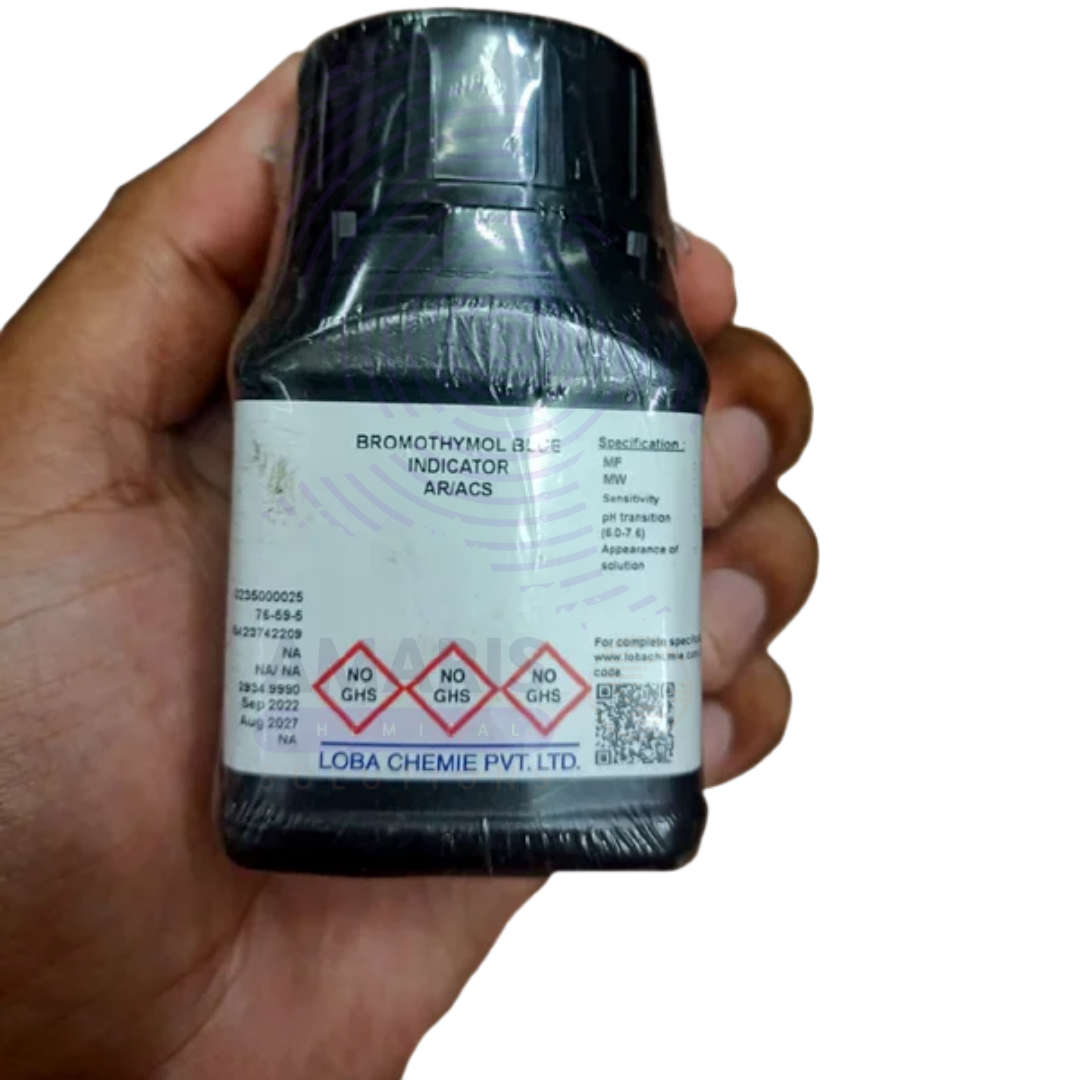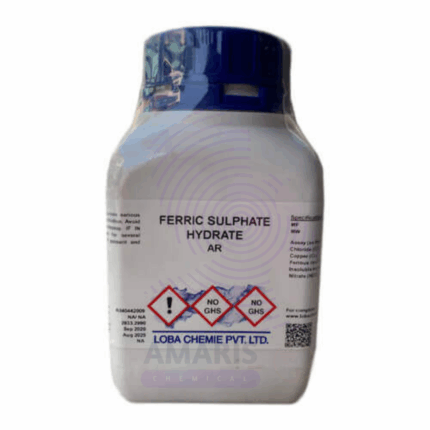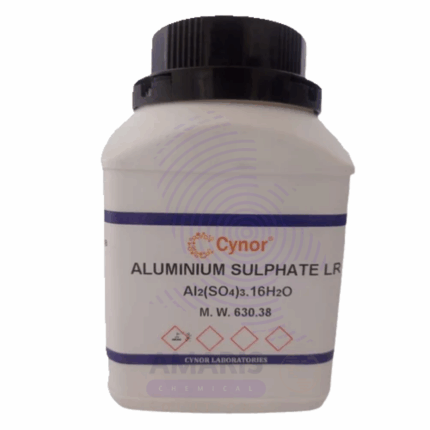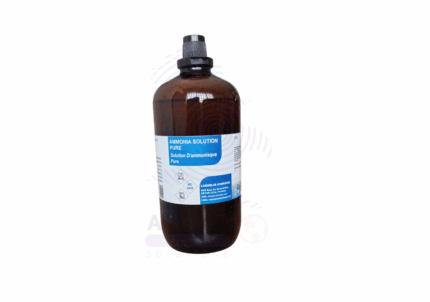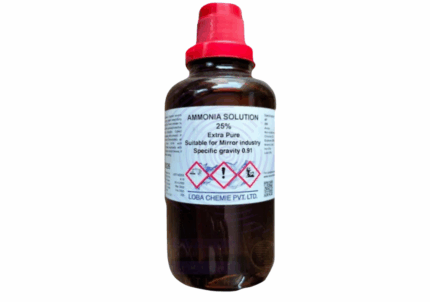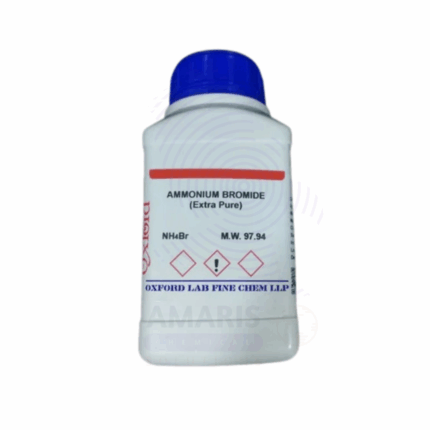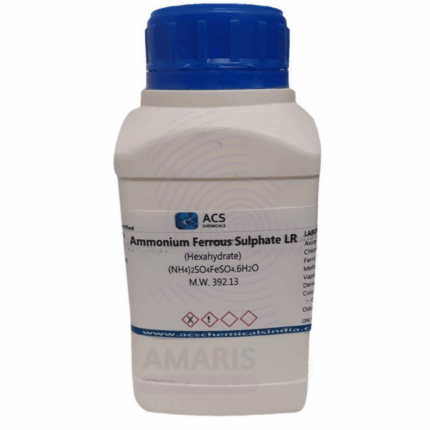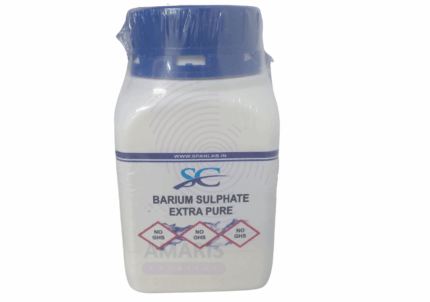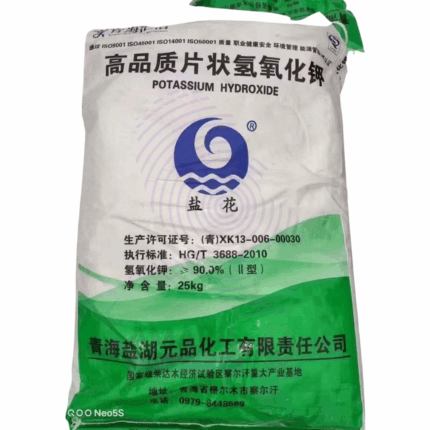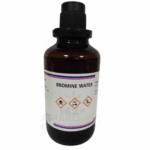
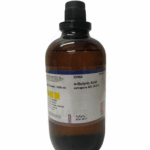
Bromothymol Blue Extra Pure
$ 18.00 Original price was: $ 18.00.$ 17.00Current price is: $ 17.00.
Bromothymol Blue Extra Pure is a high-purity pH indicator dye widely used in laboratory experiments, especially in acid-base titrations and biological research. It exhibits a distinct color change from yellow in acidic solutions (pH < 6.0) to blue in basic conditions (pH > 7.6), making it valuable for monitoring pH changes in aqueous systems. This dye is also employed in respiratory experiments to detect CO₂ levels through pH shifts. The extra pure grade ensures excellent color stability, high sensitivity, and minimal impurities, making it suitable for precise analytical and educational applications. It should be stored in a tightly closed container, protected from light and moisture to maintain its integrity.
Bromothymol Blue Extra Pure
Primary Uses
-
pH Indicator in Acid–Base Titrations
- Changes from yellow (pH < 6.0) to blue (pH > 7.6)—ideal for titrations near neutral pH (e.g., weak acid vs. strong base).
- Changes from yellow (pH < 6.0) to blue (pH > 7.6)—ideal for titrations near neutral pH (e.g., weak acid vs. strong base).
-
Buffer System Studies
- Used in buffer capacity experiments and to visually monitor pH stability in buffer solutions during kinetic or enzymatic studies.
-
Respiration and Photosynthesis Experiments
- Applied in biology labs to detect CO₂ levels:
- Yellow in acidic solutions (CO₂ dissolved)
- Blue in basic or neutral solutions
- Helps monitor cellular respiration or photosynthetic CO₂ uptake.
- Applied in biology labs to detect CO₂ levels:
-
Colorimetric Assays and Visual pH Checks
- Incorporated into colorimetric kits for rapid visual estimation of pH, especially in soil, water, and biochemical media testing.
Secondary Uses
-
Demonstration of pH Concept in Teaching Labs
- Great for classroom demonstrations showing pH shifts and acid-base neutralization visually.
- Great for classroom demonstrations showing pH shifts and acid-base neutralization visually.
-
Biological Culture Monitoring
- Sometimes added to cell culture media or fermentation broths to visually signal pH changes due to microbial metabolism.
- Sometimes added to cell culture media or fermentation broths to visually signal pH changes due to microbial metabolism.
-
Spectrophotometric Calibration
- Used in UV-Vis experiments for studying absorbance spectra of indicators, or calibrating spectrophotometers.
| PACK SIZE |
500 grams Plastic Tin |
|---|
1. Basic Identification Attributes
- Chemical Name: Bromothymol Blue
- CAS Number: 76-59-5
- HS Code: 2934.99.90
- Molecular Formula: C₂₇H₂₈Br₂O₅S
- Molecular Weight: 624.38 g/mol
- Synonyms: BTB, Bromothymol sulfone phthalein
- Grade: Extra Pure (for analytical/laboratory reagent use)
2. Physical & Chemical Properties
- Appearance: Dark green to bluish powder or crystals
- Odor: Odorless
- Solubility: Slightly soluble in water; soluble in ethanol and dilute alkali solutions
- pH Range (Color Change):
- Yellow below pH 6.0
- Green at pH ~7.0
- Blue above pH 7.6
- Melting Point: Decomposes above 200 °C (no clear melting point)
- Stability: Stable under normal lab conditions when kept dry and sealed
3. Safety & Hazard Attributes
- GHS Classification:
- Not classified as hazardous under GHS in low quantities
- GHS Pictograms: None required for typical lab-scale use
- NFPA Ratings:
- Health: 1
- Flammability: 0
- Reactivity: 0
- Health Hazards:
- May cause mild irritation to eyes, skin, or respiratory tract
- Protective Measures:
- Use lab gloves, goggles, and standard ventilation
4. Storage & Handling Attributes
- Storage Conditions:
- Store in a tightly sealed container, in a cool, dry, dark place
- Protect from moisture and strong oxidizers
- Incompatible Materials:
- Strong acids, oxidizers
- Packaging: Amber glass or HDPE bottles with desiccants
- Handling Precautions:
- Avoid dust formation; handle with care to maintain reagent purity
5. Regulatory & Compliance Attributes
- Regulatory Status:
- Listed under TSCA and other chemical inventories
- Transport Classification:
- Not regulated for transport under standard laboratory quantities
- Waste Disposal:
- Small quantities may be disposed of in regular lab chemical waste
- Follow local institutional chemical disposal guideline
6. Environmental & Health Impact
- Ecotoxicity:
- Low ecological risk at laboratory scale
- Biodegradability:
- Slowly degrades in the environment
- Bioaccumulation:
- Not expected to bioaccumulate
- Health Effects:
- Minimal unless ingested or in case of prolonged exposure
SAFETY PRECAUTIONS
- Personal Protective Equipment (PPE):
- Wear safety goggles, lab gloves (nitrile recommended), and a lab coat.
- Handle powder in a fume hood to avoid inhalation.
- Handling:
- Avoid generation of dust.
- Prevent contact with skin, eyes, and clothing.
- Wash hands thoroughly after use.
- Storage:
- Store in a cool, dry, and well-ventilated area.
- Keep the container tightly closed and protected from light.
- Keep away from incompatible materials such as strong oxidizing agents.
- Incompatibilities:
- Avoid mixing with strong acids or oxidizers.
FIRST AID MEASURES
- Inhalation:
- Remove to fresh air.
- Seek medical attention if symptoms such as coughing or shortness of breath occur.
- Skin Contact:
- Wash immediately with plenty of water and soap.
- Remove contaminated clothing.
- Seek medical advice if irritation persists.
- Eye Contact:
- Rinse thoroughly with plenty of water for 15 minutes, lifting eyelids.
- Seek medical attention if irritation or vision issues persist.
- Ingestion:
- Rinse mouth with water.
- Do not induce vomiting.
- Get medical attention, especially if large amounts were swallowed.
FIRE FIGHTING MEASURES
- Flammability:
- Not classified as flammable, but may burn if exposed to fire.
- Extinguishing Media:
- Use water spray, foam, carbon dioxide, or dry chemical.
- Hazardous Combustion Products:
- May release carbon oxides (CO, CO₂) and sulfur oxides under fire conditions.
- Firefighting Equipment:
- Use self-contained breathing apparatus (SCBA) and protective gear.
- Cool containers with water if exposed to fire.


 Preservatives(food)
Preservatives(food) Flavor Enhancers
Flavor Enhancers Acidulants
Acidulants Sweeteners
Sweeteners Antioxidants
Antioxidants Colorants(food)
Colorants(food) Nutraceutical Ingredients (food)
Nutraceutical Ingredients (food) Nutrient Supplements
Nutrient Supplements Emulsifiers
Emulsifiers
 Collectors
Collectors Dust Suppressants
Dust Suppressants Explosives and Blasting Agents
Explosives and Blasting Agents Flocculants and Coagulants
Flocculants and Coagulants Frothers
Frothers Leaching Agents
Leaching Agents pH Modifiers
pH Modifiers Precious Metal Extraction Agents
Precious Metal Extraction Agents
 Antioxidants(plastic)
Antioxidants(plastic) Colorants (Pigments, Dyes)
Colorants (Pigments, Dyes) Fillers and Reinforcements
Fillers and Reinforcements Flame Retardants
Flame Retardants Monomers
Monomers Plasticizers
Plasticizers Polymerization Initiators
Polymerization Initiators Stabilizers (UV, Heat)
Stabilizers (UV, Heat)
 Antifoaming Agents
Antifoaming Agents Chelating Agents
Chelating Agents Coagulants and Flocculants
Coagulants and Flocculants Corrosion Inhibitors
Corrosion Inhibitors Disinfectants and Biocides
Disinfectants and Biocides Oxidizing Agents
Oxidizing Agents pH Adjusters
pH Adjusters Scale Inhibitors( water)
Scale Inhibitors( water)
 Antioxidants(cosmetic)
Antioxidants(cosmetic) Emollients
Emollients Fragrances and Essential Oils
Fragrances and Essential Oils Humectants
Humectants Preservatives
Preservatives Surfactants(cosmetic)
Surfactants(cosmetic) Thickeners
Thickeners UV Filters
UV Filters
 Fertilizers
Fertilizers Soil Conditioners
Soil Conditioners Plant Growth Regulators
Plant Growth Regulators Animal Feed Additives
Animal Feed Additives Biostimulants
Biostimulants Pesticides (Herbicides, Insecticides, Fungicides)
Pesticides (Herbicides, Insecticides, Fungicides)
 Active Pharmaceutical Ingredients (APIs)
Active Pharmaceutical Ingredients (APIs) Excipients
Excipients Solvents(pharmaceutical)
Solvents(pharmaceutical) Antibiotics
Antibiotics Antiseptics and Disinfectants
Antiseptics and Disinfectants Vaccine Adjuvants
Vaccine Adjuvants Nutraceutical Ingredients (pharmaceutical)
Nutraceutical Ingredients (pharmaceutical) Analgesics & Antipyretics
Analgesics & Antipyretics
 Analytical Reagents
Analytical Reagents Solvents(lab)
Solvents(lab) Chromatography Chemicals
Chromatography Chemicals Spectroscopy Reagents
Spectroscopy Reagents microbiology-and-cell-culture-reagents
microbiology-and-cell-culture-reagents Molecular Biology Reagents
Molecular Biology Reagents Biochemical Reagents
Biochemical Reagents Inorganic and Organic Standards
Inorganic and Organic Standards Laboratory Safety Chemicals
Laboratory Safety Chemicals Specialty Laboratory Chemicals(Special Laboratory Equipment)
Specialty Laboratory Chemicals(Special Laboratory Equipment)
 Demulsifiers
Demulsifiers Hydraulic Fracturing Fluids
Hydraulic Fracturing Fluids Scale Inhibitors(oil)
Scale Inhibitors(oil) Surfactants(oil)
Surfactants(oil) Drilling Fluids
Drilling Fluids
 Dyes and Pigments
Dyes and Pigments Bleaching Agents
Bleaching Agents Softening Agents
Softening Agents Finishing Agents
Finishing Agents Antistatic Agents
Antistatic Agents
 Admixtures
Admixtures Waterproofing Agents
Waterproofing Agents Sealants and Adhesives
Sealants and Adhesives Curing Compounds
Curing Compounds Concrete Repair Chemicals
Concrete Repair Chemicals Anti-Corrosion Coatings
Anti-Corrosion Coatings
 Surfactants(cleaning)
Surfactants(cleaning) Builders
Builders Enzymes
Enzymes Solvents (Cleaning)
Solvents (Cleaning) Fragrances
Fragrances
 Electronic Chemicals
Electronic Chemicals Catalysts
Catalysts Lubricants
Lubricants Photographic Chemicals
Photographic Chemicals Refrigerants
Refrigerants Automotive chemicals
Automotive chemicals Pyrotechnic Chemicals
Pyrotechnic Chemicals
 Biodegradable Surfactants
Biodegradable Surfactants Bio-based Solvents
Bio-based Solvents Renewable Polymers
Renewable Polymers Carbon Capture Chemicals
Carbon Capture Chemicals Wastewater Treatment Chemicals
Wastewater Treatment Chemicals
 Pigments
Pigments Solvents(paint)
Solvents(paint) Specialty Coatings
Specialty Coatings Binders/Resins
Binders/Resins Additives
Additives Driers
Driers Anti-Corrosion Agents
Anti-Corrosion Agents Functional Coatings
Functional Coatings Application-Specific Coatings
Application-Specific Coatings
 Fresh Herbs
Fresh Herbs Ground Spices
Ground Spices Whole Spices
Whole Spices Spice Blends
Spice Blends Dried Herbs
Dried Herbs
 Leavening Agents
Leavening Agents Dough Conditioners
Dough Conditioners Flour Treatments
Flour Treatments Fat Replacers
Fat Replacers Decoratives
Decoratives Preservatives(baking)
Preservatives(baking)
 Plasticizers & Softeners
Plasticizers & Softeners Reinforcing Agents
Reinforcing Agents Adhesion Promoters
Adhesion Promoters Vulcanizing Agents
Vulcanizing Agents Antidegradants
Antidegradants Blowing Agents
Blowing Agents Fillers & Extenders
Fillers & Extenders Accelerators & Retarders
Accelerators & Retarders